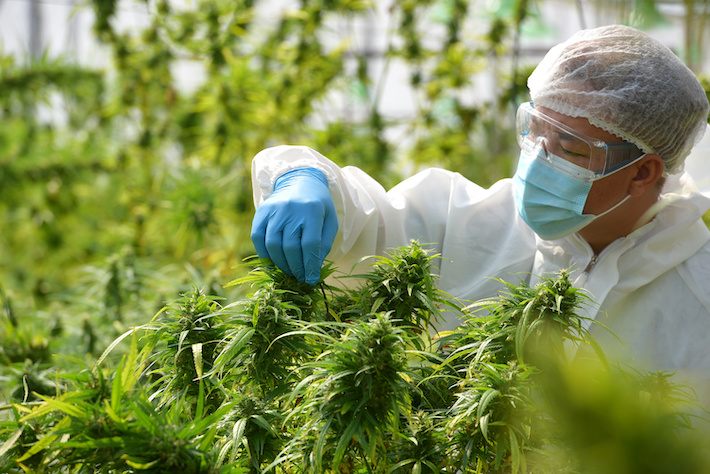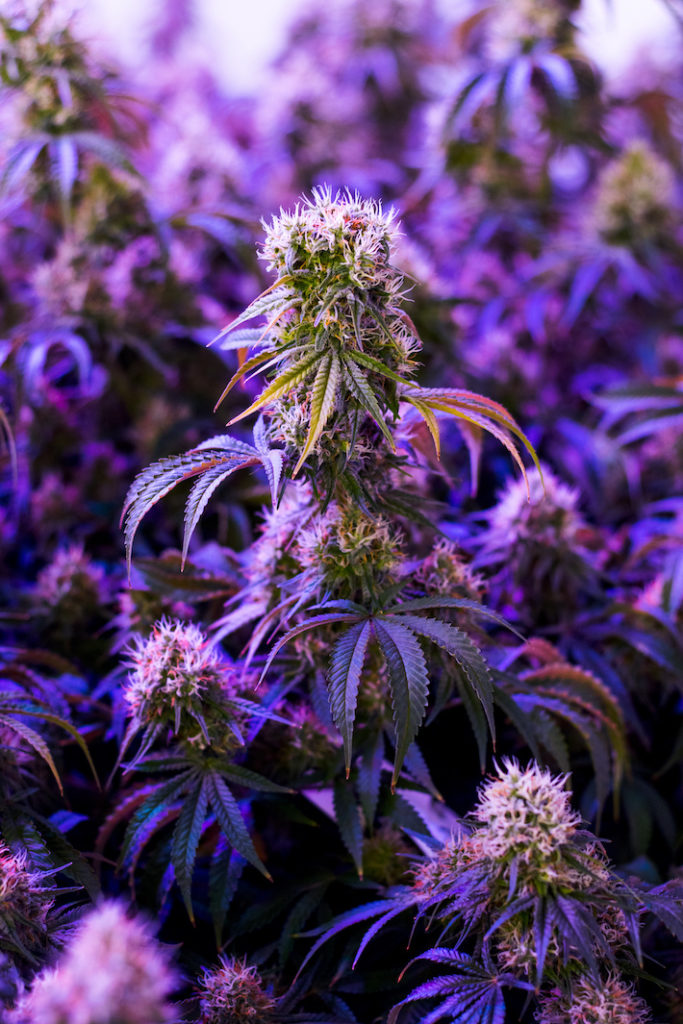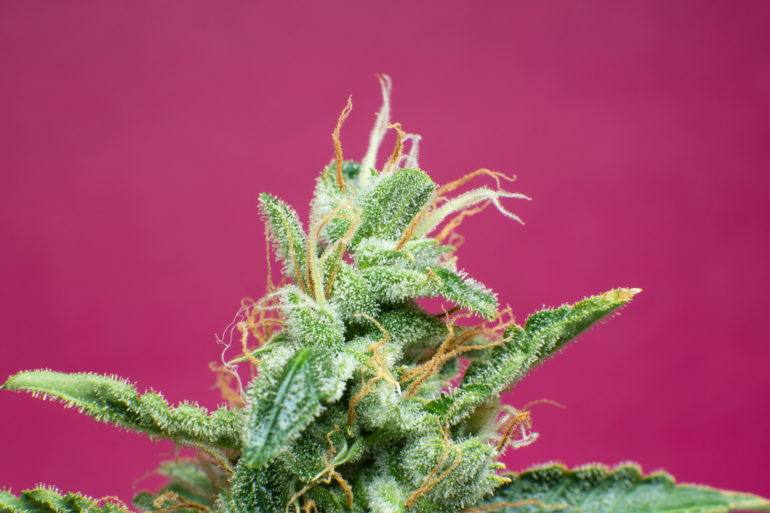Summary:
- Delta 6a10a THC is a THC isomer that occurs naturally as part of the degradation of THC to CBN.
- Users describe a delta 6a10a THC high using similar words to a delta-9 THC high (e.g. peaceful, pleasant, relaxed), but it is estimated to be 3 to 6 times less potent.
- There are potential medical uses for delta 6a10a THC (e.g. for epilepsy) but insufficient evidence to say it’s actually helpful for any condition.
- The biggest risk associated with delta 6a10a THC is the potential presence of byproducts from manufacturing in untested extracts.
- Delta 6a10a is likely to be legal under the Farm Bill, but there is some disagreement over whether it should be considered a natural cannabinoid.
For all of its oversights and flaws, one great thing about the 2018 Farm Bill is that it firmly established that delta-9 THC and CBD aren’t the only interesting cannabinoids found in the plant.
As well as delta-8 THC, THCV and others, delta 6a10a has been attracting interest from those looking for a more energetic, mild high that takes the edge off while still keeping you mentally active enough to get through your day’s tasks.
But what even is delta 6a10a? Is it legal? And what should you look out for when you’re shopping for it? Here’s what you need to know about this novel cannabinoid.
What Is Delta 6a10a THC?
Delta 6a10a-THC is an isomer of THC sometimes called delta-3 THC, which was discovered in the 1940s and occurs naturally in cannabis in some situations.
The first record of delta 6a10a-THC comes from a 1941 patent application, when attempting to synthesize delta-8 and delta-9 THC, but interest in the cannabinoid was purely academic until relatively recently.
Aside from some sparse research conducted over the intervening decades, knowledge about the cannabinoid is still very limited today.
There is conflicting information about whether delta 6a10a is a natural component of cannabis, with some arguing that it is not a known component.
We spoke to Tanja Bagar, PhD, CEO of ICANNA International Institute for Cannabinoid and a CBD Oracle Medical Advisor, about this issue, and she explained:
“This cannabinoid is seldomly isolated from the plant, whereas its anoxygenated analogue has been isolated from cannabis already in 2005. Delta 6a,10a-THC, can however be present in plant material, as an intermediate product in the oxidative aromatizatization of delta-9 THC, meaning as a product that is forming during the degradation of THC to CBN.”
So while it is not a commonly-found component of cannabis and hemp, it is present in the plant naturally in some circumstances, albeit as an intermediate. Additionally, it can be formed from delta-10 THC in acidic conditions.
Overall, despite some disagreement, Delta 6a10a THC is a natural cannabinoid.
Molecular Structure
Delta 6a10a THC is an isomer of delta-9 THC, but it is an isomer, so it has an identical chemical formula but a slightly different structure.
Both delta 6a10a THC and delta-9 THC have the chemical formula C21H30O2, but the two differ in the position of the double-bond.

Delta-9 THC has the double-bond in the 9th position, while delta-6a10a has the bond between what are now called 6a and 10a.
The naming conventions for these vary, so delta-9 THC used to be called delta-1 THC and 6a10a used to be called delta-3, but this doesn’t matter: the molecule is the same regardless of how you label the positions.
One important thing about the molecular structure of delta 6a10a is that it has two enantiomers, 1S and 1R, which have differing effects in humans. You can think of these like screws with two opposite threadings, so one would “screw in” clockwise while the other would be anti-clockwise.
In practice, this means that only the 1S version of delta 6a10a has an intoxicating effect similar to delta-9 or delta-8 THC.
Effects
Research has shown that (1S) delta 6a10a has similar psychoactive effects to delta-9 THC except considerably weaker, but evidence is limited.
In 1987, a research team including Leo Hollister and Ralph Mechoulam published a study looking at the effects of both forms of delta 6a10a in humans. The researchers compared the effects of delta-9 THC to those of delta 6a10a (called delta-3 in the study) after intravenous dosing, and found that even though ratings varied, delta 6a10a was approximately 3 to 6 times less potent than delta-9 THC.
While the cannabinoid was ranked as less strong, the words chosen to describe the experiences were very similar. For example, all subjects described both as “peaceful” and “pleasant,” and adjectives like “relaxed,” “dreamy,” “carefree” and “happy” were used to describe both cannabinoids. The only differences were minor, and with a small number of participants, it’s hard to draw too many conclusions from them.
Anecdotally, reviews of delta 6a10a products broadly agree with the participants in this study, often noting that it’s less potent than delta-9 THC, but a good choice for a more energetic, lucid and productive high.
Generally speaking, experiences with delta 6a10a seem positive, although people looking for high potency products might prefer other options.
Potential Uses
With limited research on delta 6a10a, it shouldn’t come as a surprise that the knowledge of its potential uses is limited. However, some old – and now declassified – research from shortly after 6a10a’s discovery gives some clues as to potential uses for the cannabinoid.
This document describes some research into a couple of cannabinoids in particular based on many experiments on dogs, as part of the Edgewood Arsenal experiments. In fact, delta 6a10a is called EA 1477 (i.e. Edgewood Arsenal chemical 1477) in these studies and was investigated (alongside dimethylheptylpyran, EA 1476) for a wide range of potential applications. Although EA 1476 was found to have other potential uses (such as promoting sleep), EA 1477 only seemed to have a significant impact in one area tested.
The researchers note that a 1949 study found that EA 1477 was effective in the treatment of grand mal and petit mal epilepsy, and the first piece of research on cannabis compounds and seizures from 1947 also used delta 6a10a. They calculate that EA 1476 is 200 times more potent than 6a10a, but that both substances help reduce epilepsy symptoms way before the level that causes ataxia (lack of coordination) or other neurological issues.
However, there are many important caveats to keep in mind here. The elephant in the room here is that we’re dealing with very old research tied to an MK Ultra-like clandestine government program. This doesn’t necessarily mean their conclusions are wrong, but it’s not a good start. I mean, they gave cocaine to dogs.
Even if we ignore that, the studies are very old and there doesn’t appear to have been any replication in recent years. However, we now know that CBD is effective at reducing seizures, so it’s possible that the early extractions and creations tested in these studies were high enough in CBD to create the apparent effect.
Unfortunately, with such limited evidence on delta 6a10a THC, its potential benefits are not well known at present. However, since it’s an isomer of ordinary THC, it is possible (but not at all certain) that it will offer similar medical benefits, without as strong a “high” associated with use.
This could be really great for people who want the medical benefits of cannabis while still remaining lucid and active enough to get through your daily tasks.
Dr. Tanja Bagar agreed with this assessment, commenting that:
“Since delta 6a10a is less potent than delta-9 THC, I see potential for its use in people who have very low tolerance for delta-9 THC, and also for people who are prone to anxiety and panic when using delta-9 THC. In such cases we presume delta 6a10a would offer a mind and more relaxing experience. For any other specificities we do not have enough data at this point.”
Risks of Delta 6a10a THC
Unfortunately, the limited research on delta 6a10a makes it difficult to be explicit about any risks. Provided you have a pure product, it’s likely that the risks will be minimal (as with ordinary THC), but this is not really known at the moment.
We asked Dr. Bagar whether there are any known health risks from delta 6a10a THC, and she responded that it’s “Hard to say at this point, the cannabinoid was shown to cause ataxia in dogs, pointing to possible effects on coordination, balance and speech. For people who have challenges with coordination and balance, they should be careful, or should at least be more aware of the right setting for using delta 6a10a products.”
Given the lack of knowledge about delta 6a10a THC right now, the risks we can be most sure about are general ones for basically any hemp product on the market and especially “rare” ones:
- Residual solvents and chemicals: Delta 6a10a THC is not extracted naturally from the plant, it is manufactured. This isn’t necessarily bad but if any residual chemicals are not removed, it will create an unnecessary risk for the user. The best way to guard against this is to only buy products that are backed with a Certificate of Analysis (COA) and make sure it includes safety testing.
- Unintended products: These manufacturing processes aren’t perfect either. Studies of delta-8 THC products find other forms of THC present too, which are likely created accidentally during manufacturing. These “wrong” THCs are not likely to be harmful, but it’s hard to predict exactly what manufacturers will create accidentally.
- Lack of knowledge: Even if we find a well-made product that offers pure delta 6a10a THC, what should we expect? Does it have any risks itself? It might not be likely based on what we know so far, but the fact that we aren’t sure is the biggest source of risk with delta 6a10a.
We would like to stress that we don’t expect delta 6a10a THC to be dangerous or to have some extreme effect unseen in other THCs, but it’s important to underline that this is just an assumption based on limited evidence. Many people will just discuss delta 6a10a and other THCs as if they’re basically the same as THC when it comes to benefits and risks, and even if this isn’t a bad assumption, again it’s important to remember that it is still an assumption.
Delta-9 vs. Delta 6a10a THC

Delta 6a10a THC is reportedly about 3 to 6 times less potent than ordinary delta-9 THC.
Dr. Tanja Bagar pointed out that the binding affinity of delta 6a10a confirms this general conclusion: “Delta 6a10a THC binds weakly to both CB1 and CB2 receptors, [but] the binding affinity is lower than that of delta 9 THC. That would indicate its effects are less potent.”
The study referenced earlier offers the clearest look at the effects of delta 6a10a THC vs. those of delta-9 THC, and generally shows that 6a10a is much more mild than delta-9 THC if the dosage is kept equal. Although there were only 4 participants in each group for this part of the study, those who took 6 mg of 6a10a rated their “high” at an average of 4/10, which was achieved with just a 2 to 3 mg dose of delta-9 THC.
The researchers concluded that overall, delta 6a10a is 3 to 6 times less potent than delta-9 THC. This study is from back in 1987, but there is nothing similar conducted more recently, so this remains the best comparison between the two cannabinoids.
What Dosage of Delta 6a10a THC Should You Take?
Although there still isn’t much information available, based on what we know: a dose of 15 to 30 mg of delta 6a10a THC is likely enough for a cannabis-like high. If you have high tolerance, and taking the lower end of the potency estimate, the number could be up to 50 mg.
The limited evidence isn’t the only issue with this estimate, though. Based on the market as it stands today, it’s most likely you’ll encounter delta 6a10a THC in the form of a vaping liquid, and in that case, actually estimating a specific dose isn’t likely to be very easy. Instead, it’s easier to take a more vague approach where you take some puffs for a few minutes, feel the effects, and then continue if you want to.
Moreover, one of the few commercial delta 6a10a products, manufactured by 3Chi, contains just over 22% 6a10a vs. almost 62% delta-8 THC. Since delta-8 THC is likely stronger than delta 6a10a THC, the reality is that the majority of the effects you’d feel from this vape would be the delta-8. The delta 6a10a still has an effect, but thinking about the dose of it specifically wouldn’t be especially helpful in this case, with almost three times as much of a stronger cannabinoid working right alongside it.
Is Delta 6a10a Legal?
Whether delta 6a10a is legal essentially depends on whether it’s considered a natural component of hemp, and there are contradictory claims about this. However, it seems it is a natural component of the plant (occurring in some situations), and therefore it is likely legal in the US under the Farm Bill.

The 2018 Farm Bill legalized hemp and all cannabinoids, derivatives and extracts taken from it. This means that naturally-occurring cannabinoids like delta-8 THC were legalized, but that non-natural ones like THC-O were not. This depends strongly on specific state law, with local governments usually restricting products that were produced synthetically or that contain other THCs, but sometimes being more permissive on otherwise banned cannabinoids like THC-O.
For delta 6a10a THC, this likely means that it is legal under the Farm Bill. However, as we noted above, there is some dispute about this and the question of legality is strongly dependent on the answer.
Based on the studies we’ve reviewed and the comments from Dr. Tanja Bagar, since it is an intermediary in the degradation of THC to CBN, delta 6a10a can be considered natural and is therefore legal.
Another argument you can make for delta 6a10a being legal is a ruling out of Arkansas, which included a section from the state’s now-outlawed Act 629 listing various THCs (including 6a10a) and said, “The THC substances listed above are likely legal under the 2018 Farm Bill.” The argument in this ruling is essentially that any substance that can be derived from hemp is legal provided that the result contains less than 0.3% delta-9 THC. This argument ignores the issue of only natural cannabinoids being legalized by the Farm Bill, but in this case it doesn’t matter because delta 6a10a is natural anyway.
Overall then, it seems that delta 6a10a THC is exempted from the controlled substances bill under the Farm Bill.
Shopping Advice for Delta 6a10a THC
With any rare cannabinoids, making sure you get what you’re paying for can be challenging and it’s more important than ever to do the research before you make a purchase.
In practice, many of the rules to follow are things you should always do when choosing a hemp product, but they’re more important in cases like this.
- Check the COA: Look at the Certificate of Analysis (COA) for the product you’re considering buying. There are a few things to look out for: 1) Check that it tests for (and detects) delta 6a10a/delta-3 THC. 2) Check that the product is safety tested for impurities. 3) Look for external confirmation of authenticity. If there is a QR code, for instance, scan it and download the file directly from the lab’s website if possible. This might not always be the easiest thing to check, but if the option to confirm is there, take it. If there is no COA at all, don’t buy it.
- What are you really buying? In the 3Chi delta 6a10a THC vape, there is almost three times as much delta-8 THC as delta 6a10a. While the COA does confirm the presence of 6a10a, it naturally raises a question: am I not mainly buying the delta-8 THC here? Of course the 6a10a will have an effect, but how noticeable it will be is debatable.
- Check reviews of the product or company: With the issues discussed above, reviews are especially valuable in this case. It’s always good to check reviews before buying, but with substantial doubt about what you’re actually getting when it comes to rarer cannabinoids, seeing what other users say is invaluable. You might not be able to find a review of the specific product, but if the manufacturer generally makes good products, you can be more confident about what you’re buying.
- Medical claims are never supported for delta 6a10a: As we covered earlier, the evidence on delta 6a10a THC is not sufficient to say that it helps with or cures anything. If a company is trying to sell you something and claims that it is a treatment or support for any condition, they are either making bold claims based on flimsy evidence or they are outright misleading you about what their product does. In any case, you shouldn’t buy it.
Conclusion: A Promising Cannabinoid for the Future
With at least part of the popularity of delta-8 THC coming down to its milder effects, delta 6a10a THC has a lot of potential in terms of product appeal. The problem at the moment is that there are not many products containing it, and this is likely because there’s a lot of controversy about rare and unnatural-sounding cannabinoids.
However, delta-8, delta-7, HHC and many other cannabinoids are pushing the issue every single day, and there are many states that haven’t meaningfully addressed the issues posed by the 2018 Farm Bill even today.
So while we can expect a knee-jerk ban from many places, it’s likely that some other states will follow the example of states like Tennessee and create a regulatory system that is actually prepared to deal with the range of products on the market.
For those places, the promise of delta 6a10a THC makes it a cannabinoid to keep an eye on, potentially offering mood and even possibly medical benefits while being up to six times less intoxicating as delta-9 THC.
References
- Adams, R. (1947, May 6). Marihuana Active Compounds. https://patentimages.storage.googleapis.com/d4/9c/3e/7724ed3fb34168/US2419935.pdf
- Devinsky, O., Cross, J. H., Laux, L., Marsh, E., Miller, I., Nabbout, R., Scheffer, I. E., Thiele, E. A., & Wright, S. (2017). Trial of cannabidiol for drug-resistant seizures in the Dravet syndrome. New England Journal of Medicine, 376(21), 2011–2020. https://doi.org/10.1056/nejmoa1611618
- Hanuš, L. O., Meyer, S. M., Muñoz, E., Taglialatela-Scafati, O., & Appendino, G. (2016). Phytocannabinoids: A unified critical inventory. Natural Product Reports, 33(12), 1357–1392. https://doi.org/10.1039/c6np00074f
- Hardman, H. F., Domino, E. F., & Seevers, M. H. (1957). The Chemistry and Pharmacology of Certain Compounds Affecting the Central Nervous System OF Animals and Man. Ann Arbor, Michigan. Retrieved from https://apps.dtic.mil/sti/pdfs/AD0707669.pdf
- Hollister, L. E., Gillespie, H. K., Mechoulam, R., & Srebnik, M. (1987). Human pharmacology of 1S and 1R enantiomers of delta-3-tetrahydrocannabinol. Psychopharmacology, 92(4). https://doi.org/10.1007/bf00176485
- Holly, K. J., Williams, J. B., & Hering, K. W. (2020). Degradants formed during phytocannabinoid processing. Cayman Currents, (34). Retrieved from https://www.bioscience.co.uk/userfiles/pdf/Cayman_Currents_34_Phytocannabinoids_2020SEP.pdf
- Loewe, S., Goodman, L. S. (1947) Anticonvulsant action of marihuana-active substances. Federation Proceedings, 6(1):352. PMID: 20343735. https://europepmc.org/article/med/20343735
- Meehan-Atrash, J., & Rahman, I. (2021). Novel Δ8-tetrahydrocannabinol vaporizers contain unlabeled adulterants, unintended byproducts of chemical synthesis, and heavy metals. Chemical Research in Toxicology, 35(1), 73–76. https://doi.org/10.1021/acs.chemrestox.1c00388
- Ross, S. A., ElSohly, M. A., Sultana, G. N., Mehmedic, Z., Hossain, C. F., & Chandra, S. (2005). Flavonoid glycosides and cannabinoids from the pollen of cannabis sativa L. Phytochemical Analysis, 16(1), 45–48. https://doi.org/10.1002/pca.809

